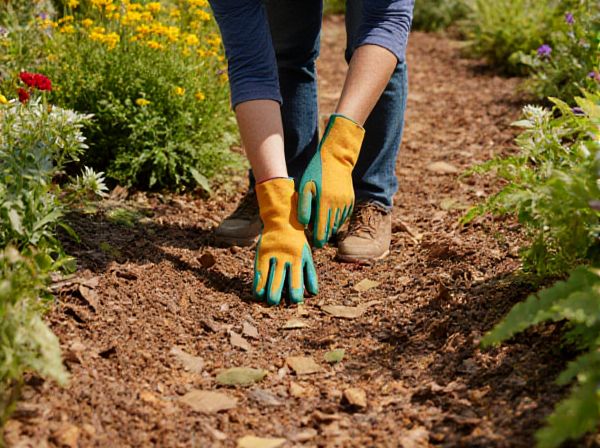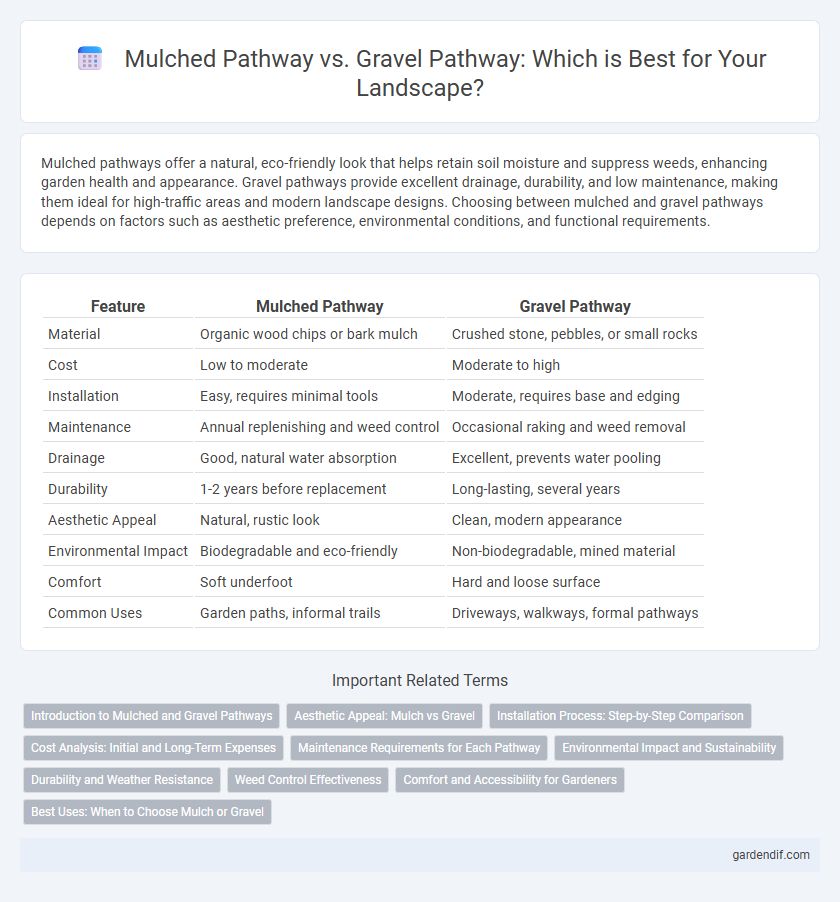
Mulched Pathway vs Gravel Pathway Illustration
Mulched pathways offer a natural, eco-friendly look that helps retain soil moisture and suppress weeds, enhancing garden health and appearance. Gravel pathways provide excellent drainage, durability, and low maintenance, making them ideal for high-traffic areas and modern landscape designs. Choosing between mulched and gravel pathways depends on factors such as aesthetic preference, environmental conditions, and functional requirements.
Table of Comparison
| Feature | Mulched Pathway | Gravel Pathway |
|---|---|---|
| Material | Organic wood chips or bark mulch | Crushed stone, pebbles, or small rocks |
| Cost | Low to moderate | Moderate to high |
| Installation | Easy, requires minimal tools | Moderate, requires base and edging |
| Maintenance | Annual replenishing and weed control | Occasional raking and weed removal |
| Drainage | Good, natural water absorption | Excellent, prevents water pooling |
| Durability | 1-2 years before replacement | Long-lasting, several years |
| Aesthetic Appeal | Natural, rustic look | Clean, modern appearance |
| Environmental Impact | Biodegradable and eco-friendly | Non-biodegradable, mined material |
| Comfort | Soft underfoot | Hard and loose surface |
| Common Uses | Garden paths, informal trails | Driveways, walkways, formal pathways |
Introduction to Mulched and Gravel Pathways
Mulched pathways consist of organic materials such as bark, wood chips, or shredded leaves that decompose over time, enriching soil health and providing a natural, soft walking surface ideal for garden settings. Gravel pathways use small stones or crushed rocks to create a durable, well-draining surface that resists erosion and requires minimal maintenance, making them suitable for high-traffic areas. Both mulched and gravel pathways offer distinct aesthetic and functional benefits, influencing water permeability, durability, and environmental impact within landscape design.
Aesthetic Appeal: Mulch vs Gravel
Mulched pathways create a natural, warm aesthetic that blends seamlessly with garden beds and plantings, enhancing the organic feel of outdoor spaces. Gravel pathways offer a crisp, clean look with a variety of color options, providing contrast and texture that can highlight contemporary or rustic landscape designs. Choice between mulch and gravel depends on desired visual impact, with mulch favoring softness and earthiness and gravel emphasizing structure and durability.
Installation Process: Step-by-Step Comparison
Mulched pathways require preparation of the soil, placement of landscape fabric, and spreading of mulch evenly, which generally takes less time and minimal equipment. Gravel pathways demand excavation to a proper depth, installation of a base layer for drainage, placement of a geotextile fabric, and spreading and compacting of gravel, resulting in a more labor-intensive process. The mulched pathway installation is simpler and faster, whereas gravel pathways offer durability but necessitate a more complex, multi-step procedure.
Cost Analysis: Initial and Long-Term Expenses
Mulched pathways generally have lower initial costs, ranging from $1 to $3 per square foot, while gravel pathways require $3 to $5 per square foot due to base preparation and material expenses. Long-term maintenance for mulch includes annual replenishment costing around $0.50 to $1 per square foot, whereas gravel paths need periodic raking and occasional gravel top-ups averaging $0.75 to $1.25 per square foot. Mulched paths tend to decompose and compact over time, necessitating more frequent replacements, while gravel pathways offer better durability but may require weed barriers and edging installations, increasing overall expenses.
Maintenance Requirements for Each Pathway
Mulched pathways demand regular replenishment every 1-2 years to maintain appearance and prevent soil erosion, along with periodic raking to avoid compaction and weed growth control. Gravel pathways require occasional raking to redistribute stones, infill with additional gravel every 2-3 years to replace displaced material, and vigilant weed barrier maintenance to suppress unwanted vegetation. Both pathways benefit from proper edging to contain materials, but mulched paths generally require more frequent upkeep compared to the lower maintenance gravel surfaces.
Environmental Impact and Sustainability
Mulched pathways are environmentally sustainable as they use organic materials that decompose naturally, enriching soil health and reducing waste. Gravel pathways, while durable and permeable, often require mining and transportation processes that increase carbon emissions and resource depletion. Choosing mulched paths supports eco-friendly landscaping by promoting natural nutrient cycling and minimal environmental disturbance.
Durability and Weather Resistance
Mulched pathways offer excellent moisture retention but tend to decompose and require frequent replenishing, reducing long-term durability. Gravel pathways provide superior weather resistance by allowing efficient drainage and preventing erosion, maintaining structural integrity during heavy rain or freezing conditions. Selecting gravel enhances pathway longevity with minimal maintenance compared to mulched alternatives in variable climates.
Weed Control Effectiveness
Mulched pathways offer superior weed control by blocking sunlight and retaining soil moisture, which inhibits weed seed germination and growth more effectively than gravel. Gravel pathways, while providing some physical barrier, often allow weed seeds to settle in gaps and require more frequent maintenance to manage weed intrusion. Consistent application and replenishment of mulch can maintain long-term weed suppression in landscaped areas.
Comfort and Accessibility for Gardeners
Mulched pathways provide a softer, more forgiving surface that reduces foot fatigue and is easier on gardeners' joints during extended work. Gravel pathways, while durable and well-draining, can cause discomfort due to loose stones and uneven footing, posing challenges for individuals with mobility issues. Mulch also offers better traction in wet conditions, enhancing safety and accessibility throughout the gardening space.
Best Uses: When to Choose Mulch or Gravel
Mulched pathways excel in garden beds and shaded areas where moisture retention and soil enrichment are priorities, promoting healthy plant growth. Gravel pathways are ideal for high-traffic zones and drainage-prone landscapes, offering durability and minimal maintenance. Selecting mulch enhances organic soil quality, while gravel provides a stable, erosion-resistant surface for walkways and driveways.
Mulched Pathway vs Gravel Pathway Infographic

 gardendif.com
gardendif.com